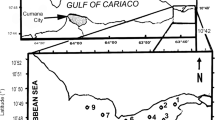Abstract
Ever since the first observations in the late 1960s, Cycliophora were found exclusively living epizoically on lobsters belonging to the family Nephropidae. The complex cycliophoran life cycle, with alternation of asexual and sexual generations, takes place only in the microhabitat provided by the host mouthparts. Herein, we report the first evidence of a symbiotic relationship between cycliophorans and organisms other than nephropid lobsters, namely, the harpacticoid copepods. Two specimens of copepods associated with cycliophoran life cycle stages were collected from the segmental mouthparts of a European lobster, Homarus gammarus. One of the copepods carried two feeding stages with long stalks, which probably belong to an undescribed Symbion sp., while the other copepod was found bearing an undetermined settled stage. We discuss the implications of these novel observations for the understanding of the Cycliophora life cycle and their dispersion abilities.

Similar content being viewed by others
References
Baker, J. M., & Giribet, G. (2007). A molecular phylogenetic approach to the phylum Cycliophora provides further evidence for cryptic speciation in Symbion americanus. Zoologica Scripta, 36, 353–359.
Baker, J. M., Funch, P., & Giribet, G. (2007). Cryptic speciation in the recently discovered American cycliophoran Symbion americanus; genetic structure and population expansion. Marine Biology, 151, 2183–2193.
Boxshall, G. A. (2005). Crustacean parasites: Copepoda (copepods). In K. Rohde (Ed.), Marine Parasitology (pp. 123–138). Melbourne: CSIRO Publishing.
Castro, M. (1992). A methodology for obtaining information on the age structure and growth rates of the Norway lobster, Nephrops norvegicus (L) (Decapoda, Nephropoidea). Crustaceana, 63, 29–43.
Funch, P. (1996). The chordoid larva of Symbion pandora (Cycliophora) is a modified trochophore. Journal of Morphology, 230, 231–263.
Funch, P., & Kristensen, R. M. (1995). Cycliophora is a new phylum with affinities to entoprocta and ectoprocta. Nature, 378, 711–714.
Funch, P., & Kristensen, R. M. (1997). Cycliophora. In F. W. Harrison & R. M. Woollacott (Eds.), Microscopic anatomy of invertebrates (Lophophorates, Entoprocta and Cycliophora) (Vol. 13, pp. 409–474). New York: Wiley-Liss.
Funch, P., & Kristensen, R. M. (1999). Cycliophora. In E. Knobil & J. D. Neill (Eds.), Encyclopaedia of reproduction (Vol. 1, pp. 800–808). New York: Academic.
Funch, P., Thor, P., & Obst, M. (2008). Symbiotic relations and feeding biology of Symbion pandora (Cycliophora) and Triticella flava (Bryozoa). Vie Milieu, 58, 185–188.
Giere, O. (2009). Meiobenthology, the microscopic motile fauna of aquatic sediments (2nd ed.). Berlin: Springer Verlag.
Huys, R., Gee, J. M., Moore, C. G., & Hamond, R. (1996). Marine and brackish water harpacticoid copepods. Part 1. Keys and notes for identification of the species. In R. S. K. Barnes & J. H. Crothers (Eds.), Synopses of the British fauna, new series 51. Field Studies Council: Shrewsbury.
Neves, R. C., Cunha, M. R., Funch, P., Wanninger, A., & Kristensen, R. M. (2010). External morphology of the cycliophoran dwarf male: a comparative study of Symbion pandora and S. americanus. Helgoland Marine Research, 64, 257–262.
Neves, R. C., Kristensen, R. M., & Funch, P. (2012). Ultrastructure and morphology of the cycliophoran female. Journal of Morphology, 273, 850–869.
Obst, M., & Funch, P. (2003). Dwarf male of Symbion pandora (Cycliophora). Journal of Morphology, 255, 261–278.
Obst, M., & Funch, P. (2005). The microhabitat of Symbion pandora (Cycliophora) on the mouthparts of its host Nephrops norvegicus (Decapoda: Nephropidae). Marine Biology, 148, 945–951.
Obst, M., Funch, P., & Giribet, G. (2005). Hidden diversity and host specificity in cycliophorans: a phylogeographic analysis along the North Atlantic and Mediterranean Sea. Molecular Ecology, 14, 4427–4440.
Obst, M., Funch, P., & Kristensen, R. M. (2006). A new species of Cycliophora from the mouthparts of the American lobster, Homarus americanus (Nephropidae, Decapoda). Organisms, Diversity and Evolution, 6, 83–97.
Plaza, M. (2012). Cycliophoran host range. Bulletin of the Peabody Museum of Natural History, 53, 389–395.
Riisgård, H. U., Nielsen, C., & Larsen, P. S. (2000). Downstream collecting in ciliary suspension feeders: the catch-up principle. Marine Ecology Progress Series, 207, 33–51.
Wells, J. B. J. (2007). An annotated checklist and keys to the species of Copepoda Harpacticoida (Crustacea). Zootaxa, 1568, 1–872.
Acknowledgments
We are grateful to the technical support by the staff from the Marine Station of Roscoff. Funding to support the collection in Roscoff was partially provided by EU programme ASSEMBLE—grant agreement no. 227799. Reinhardt Møbjerg Kristensen (Copenhagen) and Peter Funch (Aarhus) are acknowledged for many discussions on the subject.
Author information
Authors and Affiliations
Corresponding author
Rights and permissions
About this article
Cite this article
Neves, R.C., Bailly, X. & Reichert, H. Are copepods secondary hosts of Cycliophora?. Org Divers Evol 14, 363–367 (2014). https://doi.org/10.1007/s13127-014-0179-1
Received:
Accepted:
Published:
Issue Date:
DOI: https://doi.org/10.1007/s13127-014-0179-1




